In continuation of my update on metformin

Maple Syrup Urine Disease (MSUD) is a rare inherited metabolic disorder involving the dysfunction of an enzyme which breaks down three essential amino acids: leucine, isoleucine and valine. Left untreated, infants die from a toxic buildup of resulting keto-acids within weeks of birth. Those who are diagnosed early can live a normal life, but are forced to eat a very controlled, formula-based diet. The only proven treatment for the disease, which is characterized by sweet-smelling urine, is a liver transplant. Publishing in Scientific Reports, researchers at the Buck Institute show that the widely-used diabetes drug metformin reduces the toxic acid levels associated with MSUD in both skin cells derived from MSUD patients and in mice. The discovery offers the possibility of a new treatment for a disorder identified 1 in 180,000 births.
Senior author and Buck faculty Arvind Ramanathan, PhD, says metformin reduced the levels of toxic ketoisocaproic acid (KIC) in patient-derived fibroblasts by 20 to 50 percent and significantly reduced KIC levels in the skeletal muscle of mice bred to have the disease by 69 percent. "We think there is a clear path to a clinical trial and we are hoping that physicians who treat MSUD patients will start pushing in that direction," he said. "There is a definite need for novel interventions."
Ramanathan, who specializes in metabolomics, came to the MUSD discovery as he was studying various compounds and the enzymes they impact in the context of aging. The work could provide a mechanistic explanation for metformin's success in controlling diabetes and possibly extending healthspan in both animals and humans. The research also highlights similarities between a rare pediatric disease and normal aging - and shows how studying one can inform the other.
Researchers studied the enzyme BCKDH, which is defective in MSUD and also decreases in activity with normal aging. Ramanathan says decreased BCKDH is implicated in obesity and diabetes; he believes it may be involved in a number of other age-related conditions as well. Ramanathan also studied an enzyme upstream of BCKDH - called BCAT. He says in MSUD, BCAT converts leucine, isoleucine and valine to toxic ketones in the mitochondria of skeletal muscle -resulting in the muscle weakness and atrophy associated with MUSD. "We think the same process may be afoot with age-related sarcopenia and frailty," he said. "Interestingly, metformin interacts with BCAT and in our MSUD mice treatment with metformin significantly reduced toxic acid buildup in the skeletal muscle."
"This is a prime example how aging research can have a significant impact on people at any age and the work also highlights the value of studying drugs already approved by the FDA," said Brian Kennedy, PhD, senior co-author and Buck Institute CEO. "In this case, we hope our discovery will help those living with MUSD. We plan on building on these insights to further our research aimed at extending the healthy years of life for all of us."




 Itaconic acid
Itaconic acid 